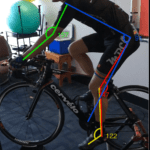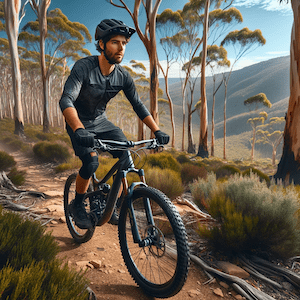Cycling Tips
Article by John Miller


Cycling Tips
A Physiotherapist’s Guide to Injury-Free Riding
Introduction
Cycling, a sport beloved by many Australians, offers a blend of adventure, fitness, and fun. However, it’s not without its challenges, particularly when it comes to pain and injuries. This guide, enriched with physiotherapist insights, is tailored to help cyclists of all levels understand how to prevent injuries and enhance their riding experience.
Professional Bike Fit: Your First Step to Safe Cycling
Every cyclist’s journey should begin with a professional bike fit. This isn’t just about comfort; it’s about preventing injuries before they occur. Can you imagine training for a marathon and not wear the best shoes suitable for your feet?
A bike fit tailored to your body’s specifics can significantly reduce the risk of common cycling complaints like wrist, neck, hip, knee and back pain. Recent studies underscore the importance of bike fitting, especially for those clocking long hours on the saddle.
More info: Bike Fitting Options
Decoding Cycling Pain: Prevention Better than Cure
Cycling injuries often stem from overuse, poor posture, and incorrect bike setup. Common issues include knee pain, sciatica, and lower back pain. Preventing these begins with understanding the root causes.
Read more: Cycling Injuries & Prevention
Latest Research in Cycling Injury Prevention
The field of cycling injury prevention is continually evolving. In this section, we highlight cutting-edge research and how it’s shaping the way we approach cycling health and safety. From new insights into muscle use to the latest in physiotherapy practices, we ensure you’re up to date with the best in cycling science.
Consult a Physiotherapist: Professional Care for Cycling Pains
Sometimes, despite all precautions, pain and discomfort can arise. Knowing when to seek professional help is crucial. This part of the article emphasises the importance of consulting a physiotherapist for tailored advice and treatment. Real-life success stories illustrate how professional intervention can make a significant difference.
Conclusion
In conclusion, this guide aims to empower cyclists with knowledge and strategies for injury prevention. From professional bike fitting to advanced cycling techniques, each element plays a vital role in ensuring a safe, enjoyable, and pain-free cycling experience.
What to Do?
If you’re experiencing discomfort or pain during cycling, don’t ignore it. Consider adjusting your bike setup as outlined, practice the recommended techniques, and most importantly, seek advice from a professional physiotherapist. They can provide targeted guidance and treatment plans to keep you pedalling smoothly.
General Bike Set-Up Guidelines
Riding Position Set Up
A comfortable and efficient riding position is vital. Your bike must be properly set up and adjusted. If your bike is adjusted to suit your particular body size and shape, you will then feel more relaxed and will be able to ride longer distances with less effort. The notes below are the most common settings that work.
Foot Position
- The ball of your foot should be centred over the pedal axle.
- Small feet and high cadence pedlars place the ball of your foot slightly behind the centre.
- If you have clip-less pedals, you can adjust your shoes into the pedal and adjust the cleat fixing bolts.
Saddle Position
Set the saddle height the following way:
- Sit on the saddle with the crank arm perpendicular to the ground and heel (shoes on) on the top of the pedal.
- Your leg should be in the straight “locked” position.
- Allow for oversized shoe heels or extra-thick soles.
- Your saddle top surface should be parallel with the road surface.
Saddle Front/Back Adjustment
- Sit on your bike in your normal riding position with the cranks in the 3 and 9 o’clock positions.
- Your saddle is correctly positioned when your tibial tuberosity (the bump at the top of the shin bone) is 1cm behind the pedal axle.
- You may need a plumb line and a helper to make this adjustment, and you may have to readjust saddle height if you move the saddle significantly.
Stem and Handlebars
- Correct stem height can be somewhere between the saddle height or as much as 6 cm below. The preferred range is 2.5 to 4.5 lower.
- Check to ensure that your knee clears your elbow when seated on your bike with the cranks in the 3/9 o’clock position.
- To ensure good chest expansion and breathing, your handlebars should be as wide as your shoulders.
- Some riders may prefer a more upright riding position on a mountain or a hybrid bike with a higher stem position.
- Extra-wide flat-type mountain bike handlebars may give more stable control on unsealed roads, but you may find them uncomfortable on long rides over sealed roads.
- Bar extensions and narrower handlebars will give you a greater variety of comfortable hand positions and place your upper body in a slightly lower position to reduce your overall resistance to the wind.
Reach
- If the handlebars are too far away, you will be very uncomfortable.
- Sit on your bike in your normal riding position, and your arms should be at 90 degrees to your torso.
Adjusting to Your New Position
It takes time to settle into the new position, and you may still have to do some fine-tuning. Overall you should feel much better when you ride and less strained when you arrive back home.
What if None of this Advice Works?
If you can’t get comfortable after making these adjustments and riding for a while, it is possible that your bike is not the right size. Considering visiting a physiotherapist with a special interest in bike setup or a cycling store professional.
More information:
Book Your Bike Fit with John Miller at Sandgate PhysioWorks.
Related Articles
- Cycling Injuries: Essential Tips For Prevention & Safety – This article provides essential tips for preventing common cycling injuries, a crucial read for cyclists looking to stay injury-free.
- Bike Fit Physio – Get The Optimal Ride At PhysioWorks – Readers can discover the importance of a professional bike fit to enhance cycling performance and comfort, addressing common pain and discomfort issues.
- What To Expect With Your Physio Bike Fit – Explains what cyclists can expect from a professional physio bike fit, including how it can address specific discomforts and improve cycling efficiency.
- Explore Our Professional Bike Fit Options – Outlines the various bike fit options available at PhysioWorks, tailored to meet the needs of cyclists at different levels of expertise and performance goals.
- Outdoor Sports – While focused on outdoor sports, this guide delves into common muscle injuries and their management, prevention, and the importance of professional advice, relevant for cyclists who also engage in other outdoor activities.
Article by John Miller
Get a Professional Physio Bike Fit
Our bike fit physio will customise both you and your bike. You'd be surprised how minor adjustments can ramp up your ride's comfort, efficiency, and performance. Who wouldn't want that?
Here's what a professional bike fit can cover.
Depending on what level of bike fit you are seeking, we can provide the following options:
- Evaluate your riding style and skill level, like recreational, aggressive elite, road, track, MTB.
- Consider your injury history, such as back pain/surgery, knee pain.
- Measure your body's dimensions.
- Pinpoint your perfect bike frame size.
- Analyze your current bike setup and compare it to the ideal.
- Check your current flexibility, joint, muscle, and neural.
- Assess your present muscle control.
- Analyze your optimal riding position via slow-motion video analysis.
- Collaborate with you to enhance your setup, riding technique, and pedal efficiency.
We'll even provide a comprehensive bike fit report (additional fee applies) with a game plan for recommended bike tweaks or exercises. It's all about fine-tuning your fit to your bike, so you both cruise efficiently and comfortably on the road, trail, or track.
Who Benefits from a Bike Fit?
- Pro cyclists.
- Keen recreational riders.
- Cyclists grappling with pain or discomfort, like knee/back/hip/shoulder/neck/wrist pain.
- Suffering from crutch/perineum pain, numbness, or pins and needles.
- Dealing with hand numbness or pins and needles.
- Fighting off fatigue cramps.
- Struggling to reach the drops comfortably.
- Cyclists who've tweaked their cycling style from the norm:
- Wobbling knees
- Saddle sliding/tilting
- Locked-out arms
- Cyclists aiming to improve their cycle efficiency (more power, same energy).
Bike Size vs Bike Fit
Most bike shops breeze through a few measurements to peg the right bike frame size. They tweak pedal and seat height too, hoping for the best. While this speedy system does the trick for many, it might not cut it for those clocking hours in the saddle or gunning for more speed and efficiency.
Yet, sometimes they botch it for you! Your body's unique. Short legs, long trunk, tricky knees – all have to mesh with your bike as best we can. Have you ever sat in another's car and had to juggle seats and mirrors? The same applies for your bike fit.
Right Bike Size, Wrong Fit!
- Regrettably, even the perfect bike size might not translate to comfy riding. Consider this:
- Stiff or inflexible riders struggle to nail that prime cycling pose.
- Weak muscle control or endurance.
- Good luck holding a comfy posture for your ride's duration.
- Pain-ridden riders.
- Physical limitations hamper a snug optimal cycling posture, like past surgery or uneven leg lengths.
A pro bike fit is as personal as it gets. Our mission is to get you pedalling better – faster, smoother, longer, efficiently and oh-so-comfy!
More information:
Book Your Bike Fit at Sandgate PhysioWorks.
Article by John Miller
Explore our Professional Bike Fit Options
At PhysioWorks, we offer 4 levels of bike fitting to cater to your needs: Platinum, Gold, Silver, and Bronze.
1. Platinum
The Ultimate Bike Fit Experience.
Combine a Gold - Standard Bike Fit, Silver - Cyclist Musculoskeletal Screening, and Bronze - Bike Frame Sizing in one comprehensive package. Ideal for elite cyclists, competitive riders, and serious recreational cyclists wishing to optimise their bike fit and performance. Allow 2.5 hours for the full experience.
Sorry! We no longer fit TT bikes.
2. Gold
The Most Popular Choice for Optimal Fit.
Optimise your bike setup with a Standard Professional Bike Fit. Perfect for cyclists who seek efficient power and minimal energy expenditure. Allow 1.5 hours for a precise fitting.
3. Silver
Musculoskeletal Screening for Peak Performance.
Enhance your cycling comfort and performance with a Cyclist Musculoskeletal Screening. Recommended for elite cyclists, high-end recreational riders, and competitive cyclists to identify regions of inflexibility or muscle weakness.. Allow 1.0 hour to assess and improve your body's cycling ability.
4. Bronze
Expert Bike Sizing Assistance.
Get professional guidance on choosing the right bike size with our Professional Bike Sizing option. Your physiotherapist will measure your anthropometrics and provide recommendations for optimal sizing. Allow 45 minutes for this service.
Time and Attention to Detail
We value your time and ensure a thorough fit. Depending on your chosen level, the fitting process will take between 0.75 and 3.0 hours. Our aim is to provide you with the best possible fit for comfort, efficiency, and performance. And that, can take time that will ultimately improve your time on the bike.
Comprehensive Reports for Your Convenience
After analysing your videos and data, we'll provide you with a detailed report outside of your consultation. An additional fee applies.
Bike Fit Gift Vouchers Available
Looking for the perfect gift for a cycling enthusiast? Consider our bike fit gift vouchers. Call Sandgate PhysioWorks on (07) 32691122 for more information.
Conclusion
Experience the difference of a professional bike fit at PhysioWorks. Your comfort, performance, and cycling enjoyment are our top priorities. Contact us today to schedule your appointment.


More information:
Book Your Bike Fit at Sandgate PhysioWorks.



